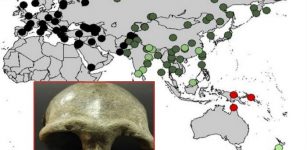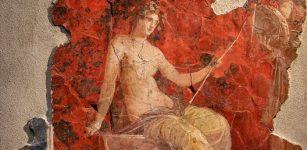Egyptian Necropolis Of Asyut And Funerary Culture That Dates Back To Old Kingdom
Jan Bartek - AncientPages.com - History of the ancient city of Asyut goes back about 4,000 years ago. Thousands of tombs carved into the rock and dating back from the Ancient Kingdom to the Roman Era attest to the rich history of the city.
 Deir el-Meitin (© The Asyut Project; J. Kahl)- in the southern part of the Assiut necropolis.
Deir el-Meitin (© The Asyut Project; J. Kahl)- in the southern part of the Assiut necropolis.
One example can be the tomb scriptures representing a great example of the classic-medieval Egyptian language. The spreading of these inscriptions for over 2000 years in Egypt demonstrates the high theological and religious-historical significance of Asyut.
The ancient city of Asyut with its palaces, temples, libraries, and houses disappeared long ago under Nile flood sediments.
Little is known about the history of Asyut, while the large city has not been highly regarded in modern Egypt.
But a joint German-Egyptian project that has thoroughly investigated the necropolis in the mountain of the Gebel Asyut al-gharbi in the west of the city can change our view of Asyut.
The excavations shed light on the monumental royal tombs, shaft tomb complexes, diverse ceiling paintings, colorful wall decorations, endless inscriptions, and grave goods.
"The finds broaden our knowledge about the history and art of a region that experienced a cultural and economic boom during the First Intermediate Period and the period of the Middle Kingdom," Professor Ursula Verhoeven-van Elsbergen of Johannes Gutenberg University Mainz (JGU), said in a press release.
 Tomb III forecourt / Tomb III Forecourt (© The Asyut Project; J. Kahl)
Tomb III forecourt / Tomb III Forecourt (© The Asyut Project; J. Kahl)
"Asyut, consequently, has a significant role to play in Egypt's cultural memory."
The large nomarchs' rock tombs of the western desert mountain of Asyut date back to the First Intermediate Period and the Middle Kingdom, i.e., about 2200 to 1900 BC.
However, the 200-meter-high limestone massif was also the site of Christian and Islamic burials after the Pharaonic Period. It was also a burial site for animals, an ancient and early modern quarry, a destination for excursions, a retreat for hermits, the site of Coptic monasteries, and, most recently, a decade-long, restricted military area.
See also:
Over 14 field seasons, researchers worked at the archaeological site and the first documentary record of individual graves dates from Napoleon Bonaparte's Egyptian campaign in 1799. The team worked on creating the first map of the necropolis with over 300 tombs, and other structures and more than 17,000 finds have been cataloged.
The discoveries also include an entirely unknown rock tomb constructed by the provincial governor Iti-ibi-iqer about 2000 BC and found in 2005.
 Tomb N13.1: Entrance and shafts at level 7, 2006 (© The Asyut Project; J. Kahl)
Tomb N13.1: Entrance and shafts at level 7, 2006 (© The Asyut Project; J. Kahl)
"Tomb N13.1 was constructed during a time of political upheaval and is therefore historically important, but it also contains well-preserved and unusual wall decorations," said Verhoeven-van Elsbergen.
These include portrayals of the tomb owner and his immediate relatives as well as of divine beings, columns of soldiers, and scenes depicting craftwork, cattle breeding, hunting, music, and dance. Particularly noteworthy are the 215 ink graffiti made by visitors 500 to 900 years later. They include praise of the local temples, writing and drawing exercises, and extensive excerpts from prominent teachings, which until now had almost exclusively been preserved from Thebes.
The longest of these texts, the Teaching of Hordjedef, extends over several walls, is eleven meters in length, and opened up important insights into the history of literature.
The information in the visitors' texts about persons, deities, and temples at Asyut in the New Kingdom (about 1550-1070 BC) is particularly valuable since the cemetery of this era has not been discovered yet.
"They're often wonderful texts. One unique example is a song that describes in imaginative comparisons and in several stanzas the beauty of the face of the local goddess Hathor," said Verhoeven-van Elsbergen.
 View of Gebel Asyut al-gharbi Credit: Fritz Barthel
View of Gebel Asyut al-gharbi Credit: Fritz Barthel
The discovery of previously unexplored burial shafts was another highlight for the members of the project.
These are architecturally unique and include a 28-meter deep shaft, which was only fully excavated after six seasons. This burial site, called Tomb I, belongs to the provincial governor Djefaihapi I (approx. 1900 BC) and is the largest tomb on Gebel Asyut al-gharbi, scheduled to be opened for tourists this year.
See also:
City Of Sais: Prehistoric Prestigious Cult Center Of Northern Egypt
Unusual Double Temple Of Kom Ombo Dedicated To Crocodile God Sobek And Falcon-Headed God Horus
How The Hyksos Invasion Of Ancient Egypt Changed History
It is the only known tomb of a high-ranking official of such a size from this period. In its original form, it was at least 120 meters long and is still preserved today over a length of 55 meters, with ceilings up to 11 meters high. The interior of the rock tomb is decorated with paintings and inscriptions carved in stone.
Project director Verhoeven-van Elsbergen describes the collaboration between the groups from Mainz and Berlin with colleagues from Sohag University, who were actively involved in the project from the start, as unique. The team consisted of about 25 researchers from around the world and up to 100 local workmen.
"The significance of the city has been reestablished, thanks to the field studies at the necropolis and our cataloged work," emphasized Professor Ursula Verhoeven-van Elsbergen.
"We have reinstated the role of Asyut in Egypt's history."
Written by Jan Bartek - AncientPages.com Staff Writer




















